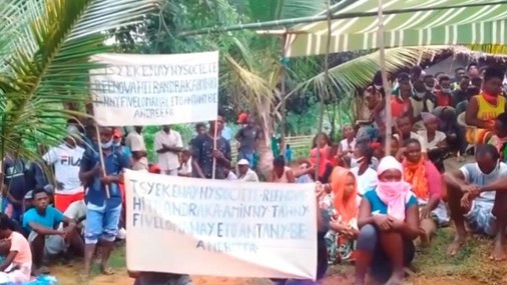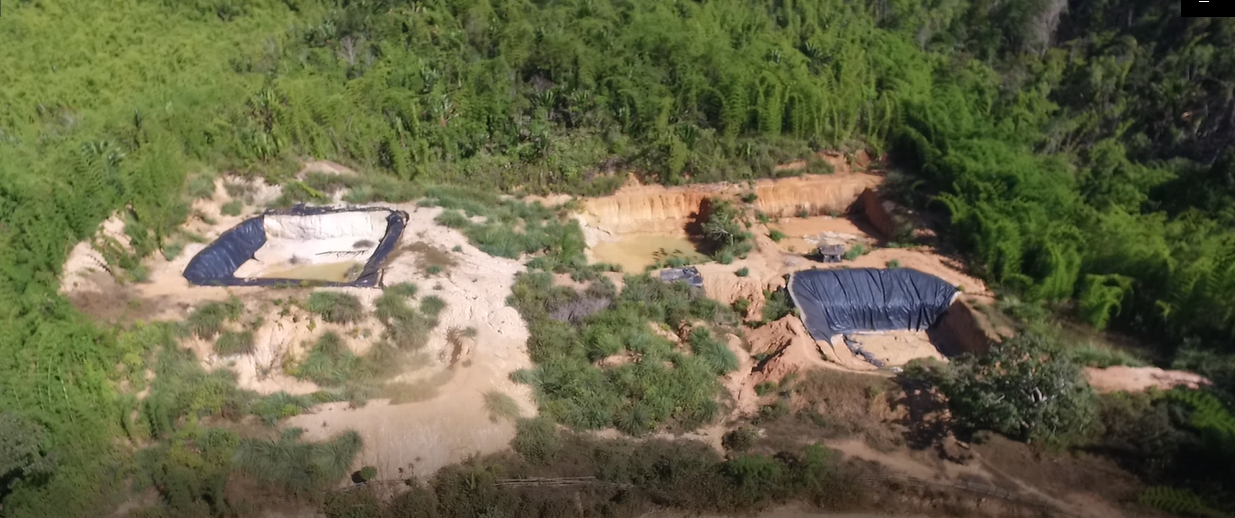Project – On record
This profile is no longer actively maintained, with the information now possibly out of dateCRAAD-OI : Centre de Recherches et d’Appui pour les Alternatives de Développement - Océan Indien
Volahery ANDRIAMANANTENASOA, CRAAD-OI (Centre de Recherches et d’Appui pour les Alternatives de Développement): volahery.andriamanantenasoa@yahoo.com

Project – On record
This profile is no longer actively maintained, with the information now possibly out of dateCRAAD-OI : Centre de Recherches et d’Appui pour les Alternatives de Développement - Océan Indien
Volahery ANDRIAMANANTENASOA, CRAAD-OI (Centre de Recherches et d’Appui pour les Alternatives de Développement): volahery.andriamanantenasoa@yahoo.com
Why this profile?
Rare earths mining risks huge environmental and human rights impacts. Affected communities have been resisting this project since 2015 and are currently opposing Harena Resources' plans to re-launch it despite proven risks and lack of communities’ consent.
What must happen
Based on the extent of community opposition, the potentially irreversible nature of the project's impacts as well as on the dubious nature of its permit denounced by communities, banks should avoid financing this project.
| Sectors | Mining |
| Location |
|
| Status |
Planning
Design
Agreement
Construction
Operation
Closure
Decommission
|
| Website | https://harenaresources.com.au/ampasindava-rare-earths-project/ |
On the northwest coast of Madagascar, the peninsula of Ampasindava is located in the district of Ambanja. It is among the last areas of primary forests of the Sambirano Domain and a coastal area particularly rich in biodiversity. The well-being of the peninsula's populations depends largely on the maintenance of these ecosystems. This fragile balance is threatened by Harena Resources Pty Ltd's rare earths mining project which could destroy thousands of hectares of natural areas and generate extremely toxic pollution, threatening the way of life of local populations, terrestrial and marine biodiversity as well as an entire economy in full mutation. Such risks include a wide range of adverse human rights impacts of the local communities.
Impact on human rights and communities
The Ampasindava peninsula is home to the last remaining forests of the Northern region and a coastal area particularly rich in biodiversity. 80.7% of the local population live in poverty and critically depend on the maintenance of these ecosystems, which provide them with numerous products (food, energy, construction materials, pharmacopoeia and sources of income) and ecosystem services (water, protection against cyclones, microclimate, soil fertility).
Since 2015, affected communities have been opposing the rare earths mining project on the basis that it will infringe on many of their human rights, including their lands rights and their livelihoods as most of them live mainly from fishing and agriculture, particularly from high value-added export crops such as vanilla, cocoa and coffee that would be destroyed by this mining project.
A number of protest actions have been undertaken by these populations for several years and are still on-going. Affected communities have been continuously calling on state authorities to stop any pilot production attempt by this project as well as to reject its request for an exploitation licence.
The destructive impacts of this mining project on the terrestrial and marine environment, human rights and livelihoods of local communities as well as on the tourism sector, the core sector of the economy of the Nosy Be archipelago, are certain.
For additional information see:
Madagascar and the New Frontiers of Sacrifice Zones, Foreign Policy In Focus, April 2023
China Wrestles with the Toxic Aftermath of Rare Earth Mining - Yale Environment 360, July 2019
Impact on climate
The climate footprint of the planned rare earths mining project will be significant, as it will be directly related to the release of greenhouse gases due to forest and vegetation cover clearance in the entire mining concession (estimated at 300 square kilometres), in addition to the indirect emissions by mining operations and the mineral value chain.
Impact on nature and environment

This project will have disastrous and irreversible impacts on the Ampasindava Peninsula, a global biodiversity hotspot that was formally designated as a protected area in 2015 over an area of more than 900 square kilometers. 80% of the plants are endemic to Madagascar, and 8% exist only on the peninsula. At least eight species of lemurs live on the peninsula, and six of these are endemic to northwestern Madagascar. Six of these are listed as endangered by the IUCN; the other two are vulnerable. In terms of the marine environment, the Ampasindava Peninsula is located in the Northern Mozambique Channel ecoregion, recognized as the second most diverse coral reef in the world. In 2012, the marine and coastal area around the peninsula was identified as a potential UNESCO World Heritage Site following a scientific assessment of the entire Western Indian Ocean. These habitats are a refuge for many endemic and threatened species, including endangered species of Lemurs.
Local communities claim that the rare earths mining project poses an imminent threat to the communities and the surrounding region. Project critics signal that, although the technology envisaged by Harena Resources Pty Ltd in Madagascar (heap leaching) is described by its Director as "a low impact operation", this process is widely known to be extremely damaging to the environment. In addition to the massive deforestation, together with the destruction of approximately 2,200 hectares of natural vegetation cover and biological resources needed for the livelihoods of local communities, chemicals such as sodium chloride, ammonium sulphate and oxalic acid, as well as a huge quantity of water must be used, leading to considerable toxic and radioactive discharges (including acids and thorium) on the land, groundwater and surrounding populations.
Communities’ concerns about the risks of mishandling toxic waste are exacerbated by the fact that Harena Resources Pty Ltd as a company has no previous experience in developing rare earths mines and using a surface filtration technology such as heap leaching. This is evidenced in the fact that its Director describes using “a weak ammonium sulfate solution”, which has proved to result in severe environmental degradation and adverse health impacts on workers and nearby communities in China. In June 2011, the Chinese central government enforced a ban on surface mining and tank/heap leaching while implementing in-situ leaching for ion-adsorption rare earths.
Indeed, the Director of Harena Resources Pty Ltd seems to ignore that to produce 1 ton of rare earths, 7 tons of ammonium sulphate and 1.5 tons of oxalic acid could be needed, as in Bayan Obo (China). According to The Guardian, "the production of one ton of rare earths generates 1,000 tons of water contaminated with ammonium sulfate and heavy metals, and 2,000 tons of toxic waste." Poisoned waters from the heap leaching process of sulfate ammonium clays in Ampasindava could be carried by rivers into the Mozambique Channel, causing marine pollution of the entire area. The torrential rains from the cyclones of Northern Madagascar would threaten to overwhelm sites where toxic sludge is stored in heaps, spreading chemicals into water and land in the entire region. Sulfate pollution of rivers and downstream reservoirs can persist long after mining ceases due to increased microbial production of hydrogen sulfate, a substance that is extremely toxic to many aquatic organisms and plants.
Thus, the destructive risks of this mining project on the terrestrial and marine environment, human rights and livelihoods of local communities as well as on the tourism sector, the core sector of the economy of the Nosy Be archipelago, are very high.
Rare earths mining is known around the world to be seriously and irreversibly destructive for the environment and people’s health as demonstrated by experiences in China and Mongolia published in several media reports.
Impact on pandemics
As has been well established by the literature on the root causes of the COVID-19 outbreak, the considerable tropical deforestation that would be associated with the planned rare earths mining project would definitely increase the risks of such emerging zoonotic disease with pandemic potential.
Other impacts
A number of protest actions have been undertaken by local communities for several years and are still on-going. It is clear that these affected populations, supported by local, regional and international civil society organisations and in solidarity with people from other regions, will continue actively opposing and challenging the project indefinitely. This is likely to have a critical impact on the performance of this mining project.
Another mining project, operated by a publicly traded Australian company listed on the ASX, in the southwestern region of Madagascar has been suspended since December 2019 due to the lack of consent from affected communities. That project also faced long-term resistance and protest actions. Given this, we believe community opposition is a material risk which has not been disclosed properly by Harena Resources Pty Ltd.
This project poses material risk to Harena Resources Pty Ltd and its prospective shareholders due to the unsustainability of its planned operations combined with enduring and large-scale community resistance that is likely to impact the company’s ability to operationalize the mine and realise the expected financial outcomes.
Australian stockbroker GBA Capital was the lead manager on a Senior Secured Convertible Note issued in April 2023: see the term sheet summary here.
Australia's Harena Resources is the 75% owner of the Ampasindava Rare Earths Project. It is unknown who owns the remaining 25% stake (held by Tantalus Rare Earths AG of Germany until August 2021).
Project sponsors
Shareholders of Harena resources include Arlington Capital Pty Ltd (Australia), Almaretta Pty Ltd (Australia), Tomori Enterprises Limited (Hong Kong), Red Warthog SMSF (Indigo Buffalo Pty Ltd), (Australia), Vivien Enterprises Pte Ltd (Australia) and Pure Ice Ltd (Saint Kitts And Nevis). See Reenova disclosures here.
David Ledger, partner at MST Financial, is an authorised representative of Arlington Capital Pty Ltd which is an authorised representative of MST Financial.
2024
2024-02-08 00:00:00 | Project History to January 2024
In February 2009, a coup d’état deposed President-elect Marc Ravalomanana during his second term. Andry Rajoelina became the president of the High Transitional Authority, which ruled the country until 2013, and granted in October 2009 to Tantalum Rare Earth Malagasy (TREM) the exploration licence for the Ampasindava concession, which consists of 48 mining blocks with a total area of 300 square kilometres. Ampasindava has been considered as one of the most promising rare earth deposits outside of China since December 2011, following an estimate of its mineral resources at 104,000 tons of rare earth oxides.
Despite the dubious nature of its mining permit—which was issued by the Transitional Regime, which did not have the authority to make long-term commitments on behalf of the country—the company had started its research operations with thousands of test pits drilled throughout its mining concession.
TREM’s failure to rehabilitate many test pits and the complaints of peasants about its research operations conducted without their prior consent led to the mobilisation by a local peasant organisation of a large part of the communities neighbouring the rare earth exploitation project. Several NGOs working in the environmental field then joined the effort.
TREM has also had several shifts in ownership. In 2016, a majority of shares went to a Singapore-based company, ISR Capital. Then, in 2020, control shifted back to a Mauritius-based company, Reenova Rare Earth Malagasy (RREM). Faced with strong opposition from affected communities, RREM attempted to restart operations.
It is worth mentioning that this project has been surrounded by many judicial upheavals since the beginning. ISR Capital has been under investigation for financial misconduct due to its connection with a person involved in the worst financial crimes in Singapore’s history, and Reenova has been placed under Judicial Management since August 2022 . In April 2023, the mining project was purchased by the Australian company, Harena Resources Pty Ltd.
